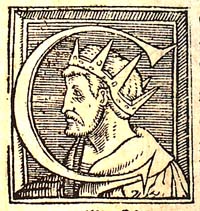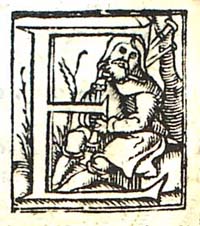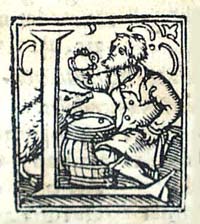Publishers and printers are hard to separate in the 15th and 16th centuries, and often were one in the same person, serving in different capacities as conditions dictated. The publishing history of Cosmographia demonstrates the collaborative and changing nature of book production in this period.
The printer of the first edition of Cosmographia, Johann Weyssenburger, had two rather different occupations: he was a printer as well as a Catholic priest. His first books were printed at Nuremberg and included both religious and secular titles. Biographers award Weyssenburger a place in the history of book illustration for the beauty and quality of his woodcuts. Perhaps some of his works included volvelles, the working paper (or vellum) instruments so distinctive in Cosmographia. These devices existed in manuscript books before the invention of printing, and are included in several printed works including Regiomontanus' Calendarium, printed in Nuremberg in 1474. It is possible that Weyssenburger learned how to print and make volvelles in Nuremberg and brought that skill with him to Landshut, where he moved his printing operation in 1513.
Weyssenburger's edition of Cosmographia is printed in gothic type and its title page is printed in red and black ink. Cosmographia seems primarily to have been a teaching text, based on its subject matter, small size, and economical layout. Weyssenburger designed a book that was still identifiable in the last edition printed eighty-five years later, although it had been modified in small ways over the years. The collaboration between Apianus and Weyssenburger made for a beautiful and useful book, and may have made volvelles a popular feature in other astronomical or cosmological books in the 16th century. Curiously, Weyssenburger is not heard of again after 1531.
|
click for larger image. |
This is possibly the monogram of Gemma Frisius, by whom this edition was "studiously corrected." A fourth volvelle showing the phases of the moon, not present in the original edition, appears in 1529, perhaps at the direction of Gemma. The 1529 title page of Cosmographicus liber states that the books are for sale at the establishment of Rolandi Bollaert, about whom, unfortunately, little is known.
Bollaert wrote and signed the "avis au lecteur" on the verso of the 1529 title page, and, as publisher, may well have made the financial arrangements securing Gemma's participation, which made the book more likely to succeed commercially. The colophon tells us that the actual printing was done by Ioan. Grapheus. R. A. Peddie in his Printing A Short History lists Johannes Grapheus second in a list of seventeen printers of Antwerp enumerated according to their importance. The books from this edition were offered for sale in Louvain by Servatium Zassenum and in Antwerp by Gregorium Bontium. Printing was a commercial undertaking in which a number of people shared the financial risks. The making of books was a trade as well as a craft, involving their sale as well as their production. It is impossible to unravel the complexities of the relationship between Apianus, Gemma, Bollaert, Grapheus, Zassen, and de Bonte from this distance, but this edition of Cosmographia clearly illustrates the collaborative nature of 16th century book production.
|
Gregorio de Bonte click for larger image |
|
click for larger image |
Birckman's device appears in numerous versions of Cosmographia, including that of 1539 from which this illustration is taken. It was printed by G. Coppens de Diest. These two men collaborated again to produce the 1540 edition as well. Arnold Birckman died in 1542, but the family continued to use the printers' device emblazoned with his name as founder. The heirs of A. Birckman published the 1564 Antwerp edition (using G. Coppens de Diest as printer again). By 1574, however, the heirs had moved to Cologne, where that year's edition was issued by an unnamed printer.
There was only one other version of Cosmographia that came from Cologne. It was the Cosmographiae introductio, produced in 1544 by the heirs of Gymnicus. This work had a dedication to Johann Dryander (or Eichmann), a physician, astronomer, and professor at the university in Marburg. Johann Gymnicus (1516-1544) was a noted Cologne publisher/printer, who produced religious works, humanist tracts (by Erasmus, among others), and even the 1520 re-print of Malleus maleficarum (The witches' hammer). He is thought to have had business contacts and possibly an office in Antwerp. Two of his sons, Martin and Johann, continued the father's publishing business.

|
|
De Nicolinis appears to have had an arrangement with the de Sabio brothers (Fratres de Sabio) in this venture, for their name appears in the colophon together with that of the Venetian printer Melchioris Sessae. Sessa printed all of the editions with which the de Nicolinis were associated (1533, 1535, 1541, and 1551).
The other Venice publisher connected with Cosmographia is the firm of Bindoni et Pasini. The partnership of Francesco Bindoni and Maffeo Pasini began in 1524 when Bindoni, an editor-publisher-printer, joined with Pasini to establish a publishing firm connected with a shop whose insignia or device was the Archangel Raphael. Three editions of Cosmographiae introductio are attributed to this firm, but it is more likely that only two were issued. The first was in 1537, bearing the names of both Bindoni and Pasini, and the last in 1554, with Bindoni's name alone. There are known copies with MDXXXVII (1537) on the title page, but MDLIIII (1554) in the colophon, and it seems likely that this dating error was detected during the printing. Those books already printed were not corrected or destroyed, but made it into the market where they confuse and perplex bibliographers.

|
|

|
|
In 1574, his role seems to be more that of the printer, as this edition states that it was printed by Verwithaghen and part of the run sold to J. Bellere and part to Antwerp's most celebrated publisher/ printer, Christophel Plantin. It is the Plantin copy that is featured on the home page of this virtual exhibit. A third part of this print run bears only Verwithaghen's name.
Verwithaghen appears to have had two partners again in a large run of Cosmographia produced in 1584, part of the run going to Bellaert, part going to A. Conincx, and part remaining for himself.
Jacob Bellaert was a famous early printer in Haarlem, printing fifteen titles between 1483 and 1487. It is certainly possible that Johann Bellaert, a known bookseller at Antwerp from 1553 to 1595 is in some way related to Jacob. (His name is variously recorded as Bellere, Bellerus, Beelaert, and Belaert.) Johann is also known for a work printed at Douai in 1575, reminding us of the religious tensions in the Low Countries throughout the 16th century. Records indicate that Bellaert was born in 1526, became a citizen of Antwerp in 1553, that he was admitted to the St. Lucasgild of book craftsmen as "vrijmeester boekverkooper" in 1559. He died in 1595.
Arnout Conincx was active as a printer and bookseller in Antwerp from 1579 to 1608, but he had a short involvement with Cosmographia, only involved with two versions, one Latin and one French, both published at Antwerp in 1584.
The last glimpse we have of Verwithaghen is in the 1592 Dutch edition, which was issued by his widow, and printed by a new name in a new location, C. Claeszoon of Amsterdam. Claeszoon was known as an Amsterdam printer from 1582 to 1609, and he issued two other editions after the one he produced for Verwithaghen's widow, all in Dutch. One came out in 1598 and the other, the last of all editions of Cosmographia, came out in 1609, the year of Claeszoon's death.
|
|
|
|